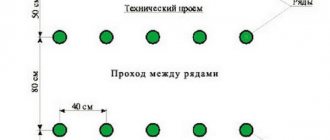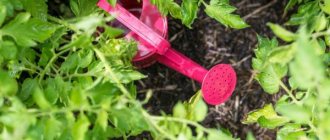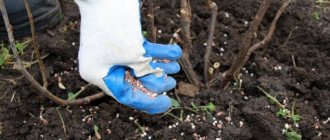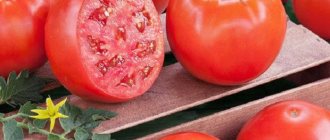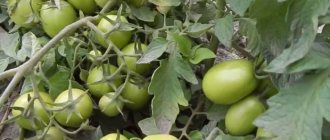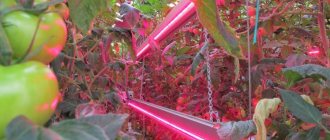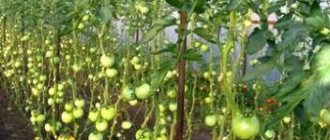Planting schemes
When planting tomato seedlings in cultivation structures, a strip scheme is usually used. The parameters in this case are maintained based on the characteristics of the culture.
Table 1: Schemes for planting tomatoes in a greenhouse
| Varieties | Distance, cm | |
| between the tapes | between the rows | |
| short | 80-90 | 50 |
| tall | 90-100 | 60 |
When growing tomatoes on a shelf, the row method is used with a distance of 60 cm. The gap between plants is 40 cm.
The number of bushes for a greenhouse is 3 by 4 and 3 by 6
Knowing the size of the greenhouse and the distances in planting patterns, it is not difficult to make calculations for the number of seedling bushes. The beds are formed along the long side of the structure. In this case, the length of the rows will be 4 and 6 m.
With a greenhouse width of 3 m, the summer resident will be able to lay one tape in 2 rows in the center and 1 row along the side walls. A total of 4 rows are obtained.
Table 2: Average calculation results
| Varieties | Quantity per row, bushes | Total bushes | |
| 3x4 m | 3x6 m | ||
| undersized/standard | 10/14 | 14/20 | 40/56 and 56/80 |
| tall | 7 | 9 | 28 and 36 |
If you plan to plant bushes of different heights in one greenhouse, then it is better to allocate a central ribbon for tall ones, and side rows for short ones. If you place the plants in a checkerboard pattern, the bed can be compacted a little.
Common mistakes
Novice gardeners often make mistakes when planting tomatoes in open ground.
Let's sort them out.
- Planting next to nightshades. Tomatoes are relatives of potatoes, peppers and eggplants, so it is advisable to plant them away from each other so that they do not get sick.
- It is also a mistake to grow tomatoes where potatoes, peppers or eggplants grew last year.
- Planting too often. In an attempt to save space, gardeners often plant seedlings in open ground too close to each other. But you can’t do that. Tomatoes need room to grow, and neighbors will compete with each other for micronutrients and sun.
In addition, in dense plantings there is no air movement. All this leads to the rapid spread of diseases.
- Supports for tall tomatoes are not used. Because of this, they grow crooked under the weight of the fruit and often lie on the ground, which provokes various rots.
- Varieties of tomatoes are planted interspersed. This significantly complicates care and also reduces the yield of low-growing tomatoes growing in open ground.
How to properly plant tomatoes in a greenhouse
Prepare the enclosed space in advance, assessing its sanitary condition and removing the remains of predecessor crops. The first step in the new season is preparing the soil. It is dug up to a depth of 25-30 cm. At the same time, compost (1.5-2 buckets/sq.m) and mineral water are added under the shovel:
- simple (or double) superphosphate – 100 (50) g;
- potassium chloride – 30 g;
- potassium magnesia – 50 g;
- sulfates: iron and copper – 5 g each.
If cucumbers were grown in these beds before planting tomatoes, then instead of compost when digging, crushed sphagnum peat or sawdust (a bucket per 1 sq.m.) is added to the soil. Nitrogen fertilizers are not used at this time.
Then plant tomatoes for next year. What to plant after tomatoes
Planting tomatoes
A day or two before planting the seedlings in the ground, the beds are thoroughly soaked with water to a depth of 10-15 cm. Under each bush, holes are formed on a flat surface according to the chosen pattern.
To ensure that the rows are even and the planting step is maintained, it is recommended to use a stretched cord and a marker.
Only well-developed healthy seedlings are selected for cultivation. It is lowered into the ground vertically, deepening along the cotyledons. Those tomatoes that will develop on the trellis are immediately tied to a pre-stretched twine. Having finished planting, the beds between the rows are loosened and leveled with a rake.
Tomato care
Growing tomatoes in greenhouses requires compliance with basic regimes. They will vary slightly depending on the time of year.
Table 3: Regimes for growing tomatoes in a greenhouse
| Mode | In heated winter | In spring | Summer-autumn turnover |
| Temperature* | The soil warms up to 18-20 degrees. The air temperature changes according to the development phase of tomatoes: - before flowering 22-24° on a sunny day and 18-20 on a cloudy day; at night 15-16°; - budding - the indicators increase by a couple of degrees; - fruiting - temperature rises another 2° | The same temperatures are maintained throughout the entire period: — on a sunny day 21-23°; — on cloudy days 18-20; — at night 15-16 | The regime changes depending on the month: — July-August: 24-26c (18-20p) during the day; 16-17 at night; — September-October: on a sunny day it is reduced by 4°, on a cloudy day by 1; at night by 2; — November: 18-20s (17-19p) during the day, 14-15 at night The temperature in the soil is maintained at 17-18° throughout the season. |
| Humidity | To ensure better pollination, a relatively dry climate is maintained in the greenhouse. | ||
| Watering** | Moderate, as the soil dries with water 20-25 degrees | Watering is rare but plentiful. The soil should be wetted to the entire depth of the fertile layer. Use warm water, not lower than 15° | In the summer months, they adhere to the spring regime. From September to November they gradually switch to winter |
| Feeding | Carried out in stages: - after rooting; - during the first ovaries; - during fruiting Use a mixture of urea, superphosphate, potassium sulfate | Tomatoes are fed 4-6 times per season, maintaining an interval of 2-3 weeks. The composition of fertilizers depends on the development phase: — at the beginning of the growing season, the ratio of potassium and nitrogen is 3:1 (or 2:1); – after fruit set – 1:1 (or 1:2) | Fertilize less frequently compared to other periods and are not tied to development phases. Use phosphorus-potassium fertilizers |
*The air in the greenhouse should not rise above 30 degrees. Otherwise, neither plant pollination nor fruit setting will occur
**Wiring is carried out in the first half of the day, so that by night you can safely open the greenhouse for ventilation (a great way to reduce air humidity)
On tall bushes, stem formation is carried out. In varieties with continuous growth, development of more than 2 m in height is not allowed (the apical point is pinched).
Symptoms of regime violation
When growing tomatoes indoors, compliance with the regimes determines the quality of the future harvest. The development of crops must be closely monitored in order to correct deviations in time.
Table 4: Signs of deviations in cultivation regimes
| Factor | Description |
| Eating disorder | |
| Nitrogen | The deficiency of the component is manifested by reddish-purple veins on the leaves. Stems become thinner, fibrous and hard Excess of the chemical leads to rapid growth of bushes, but slows down flowering. Leaves turn deep green |
| Phosphorus | When there is a deficiency, the cotyledons of tomatoes begin to actively grow upward. Their undersides take on a purple-red hue. The leaves curl up, the plant itself is delayed in development Excessive application of phosphorus provokes the development of chlorosis |
| Potassium | Deficiency slows down the growth of bushes, making them sluggish. Leaves become brittle. First, their edges curl, then bronze spots appear; tissues turn brown and die Due to the excess, the peduncles are shortened, the color of the flowers deteriorates, the lower leaves turn yellow |
| Magnesium | Deficiency leads to chlorosis. The upper unpaired lobe of leaves turns pale |
| Improper watering | |
| Excess moisture | Leads to root rotting. The color of the leaves fades, they become flabby and droop. Growing brown putrefactive spots appear on the plates. A bush can lose all its foliage overnight |
| Flaw | Tomatoes slow down in growth. The leaves droop, starting to turn yellow at the tips. Then they turn brown, wrinkle and fall off. If the problem occurs at the flowering stage, but the flowers also fall off |
| Humidity is not maintained | |
| Low | The leaves lose their elasticity, and their tips turn brown and wrinkle. The edges turn yellow. Flowers dry out and later fall off |
| High | Putrefactive spots appear on any part of the bush, not similar to those that indicate infection with infectious diseases |
| The temperature regime is down | |
| Heat | Due to prolonged intense heat, the ground part of tomatoes turns yellow, starting from the tops. If no action is taken, the bush turns brown and withers. The tips of the sheets dry out, the plates sometimes curl. The roots also suffer, which ends tragically - the plant dies |
Prolonged violation of the basic regimes in the greenhouse will lead to the development of rot, the appearance of powdery mildew, late blight, anthracnose, fusarium and other equally dangerous problems.
Useful tips
In order for tomatoes to develop well in closed soil conditions and not get sick, it is recommended to listen to the advice of experienced farmers:
- when growing crops in greenhouses, a limited volume of soil is used, which is quickly depleted if it is not fed; When applying fertilizers to the beds, the dosage is slightly larger than for open-air areas;
- the soil itself in greenhouses should be updated every year with a layer of 5-10 cm; if tomatoes are grown in racks, then the soil is completely changed every 2 years;
- when controlling the temperature regime, you should not limit yourself to 2 thermometers (on the soil and near the ridge) - it is better to distribute them evenly throughout the greenhouse;
- you should not ignore the ventilation of the structure - this is one of the methods of regulating the regimes;
- when watering, it is important not only the amount of moisture, but the temperature of the water - cold liquid will lead to a failure of the immune system;
- if plants signal a lack of one or another nutrient, you should not apply the whole complex to the beds - use only monofertilizer;
- when tomatoes lack moisture, when adjusting the regime, sudden changes should not be allowed - the soil is irrigated in small volumes, watering the plants every other day, until the negative symptoms disappear completely.
Phytohormones like “Auxin” will help increase the resistance of tomatoes to violations of agricultural practices.
Choose the right variety
Tomatoes come in a variety of shapes, sizes and colors. While some of this has to do with climate and personal preference, there is one key difference every gardener should know: determinate vs. indeterminate tomatoes.
Determinate (or bush) tomatoes typically fruit for two weeks and then stop, making them great for canning. They are also more compact, making them a smart choice for small areas.
Indeterminate tomatoes produce longer vines and flavorful fruit throughout the season. The most common varieties fall into this category.
